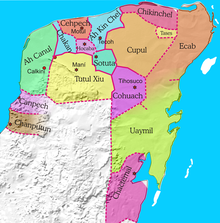Cuchcabal
Cuchcabal is the name of the Mayan principalities in Yucatán in the local language ( Mayathan ) during the late post-classical period .
history
The Cuchcabal emerged at the latest with the fall of Mayapán in 1461, but some of them already existed before as domains or provinces, some of them can be proven up to the time of the hegemonic power of Chichén Itzá or its fall in 1224. The Cuchcabal existed until the time of the Conquest and were only dissolved by the Spanish in the 16th century through restructuring.
Around 1500 there were 16 such territories in Yucatán: Ah Canul , Ah Kin Chel , Ceh Pech , Can Pech, Chactemal , Chakán , Chan Putum , Chikinchel, Cochuah , Cupul , Ekab , Hocabá , Sotuta, Tases, Tutul Xiu and Uaymil.
Another Maya principality, which was also founded from Chichén Itzá in 1194, was Tayasal on an island in Lake Petén Itzá . It did not come under Spanish rule until 1697. However, the name Cuchcabal can in no way be transferred to Tayasal or the principalities of the Highland Mayas, which were destroyed in the 1520s, since Mayathan was not spoken there.
Politics and administration
The political structure of the individual Cuchcabal was very different and could vary widely. In any case, the local nobility , which constituted the secular and clerical upper class, always had the executive , legislative and judicial branches .
From the smashing of the so-called League of Mayapán , the Tutul Xiu emerged victorious, but only ruled their own principality with the capital Maní . Some of the central north-western principalities of the Yucatán, Ah Canul, Ah Kin Chel, Can Pech and Hocabá were supporters or coalition members of the Xiu. The Cocom, however, who - after they had left Mayapan - resided in Sotuta and also only ruled this principality, were still a leading power. Cochuah and Cupul were loyal allies of the Cocom. In this way, a polarity cultivated in enmity in the Yucatán emerged, which was also reflected in the Conquista. The Xiu welcomed the Spaniards in a friendly manner and formed a coalition with them, while the Cocom and their allies embittered and successfully resisted for a long time.
The individual Cuchcabal were often at war with one another, sometimes continuously, but there was also a culture of diplomatic exchange and trade with one another. There were also common religious centers, for example on Cozumel or in Chichén Itzá, perhaps also in Izamal .
Some of the Cuchcabal were ruled centrally by a Halach Huinik , to whom the Batab were subordinate as city princes. In addition to Tutul Xiu and Sotuta, these included Ah Kin Chel, Ceh Pech, Cochuah and Hocabá. No central power could establish itself in the other principalities. There the Batab ruled alone. In Ah Kanul and Cupul, for example, the families of the same name were able to provide the majority of the Batab, which made it easy to implement an adequate and coordinated policy. The remaining Cuchcabal, not mentioned so far, were also ruled exclusively by Batab, who occasionally also acted against each other, for example in Chikinchel. Both the position of Halach Hunik and that of Batab were reserved for the nobility and were inherited patrilinearly .
literature
- Berthold Riese : The Maya: History - Culture - Religion. Munich 2006, pp. 109–116
- Ralph L. Roys : The Political Geography of the Yucatan Maya. Washington 1957
